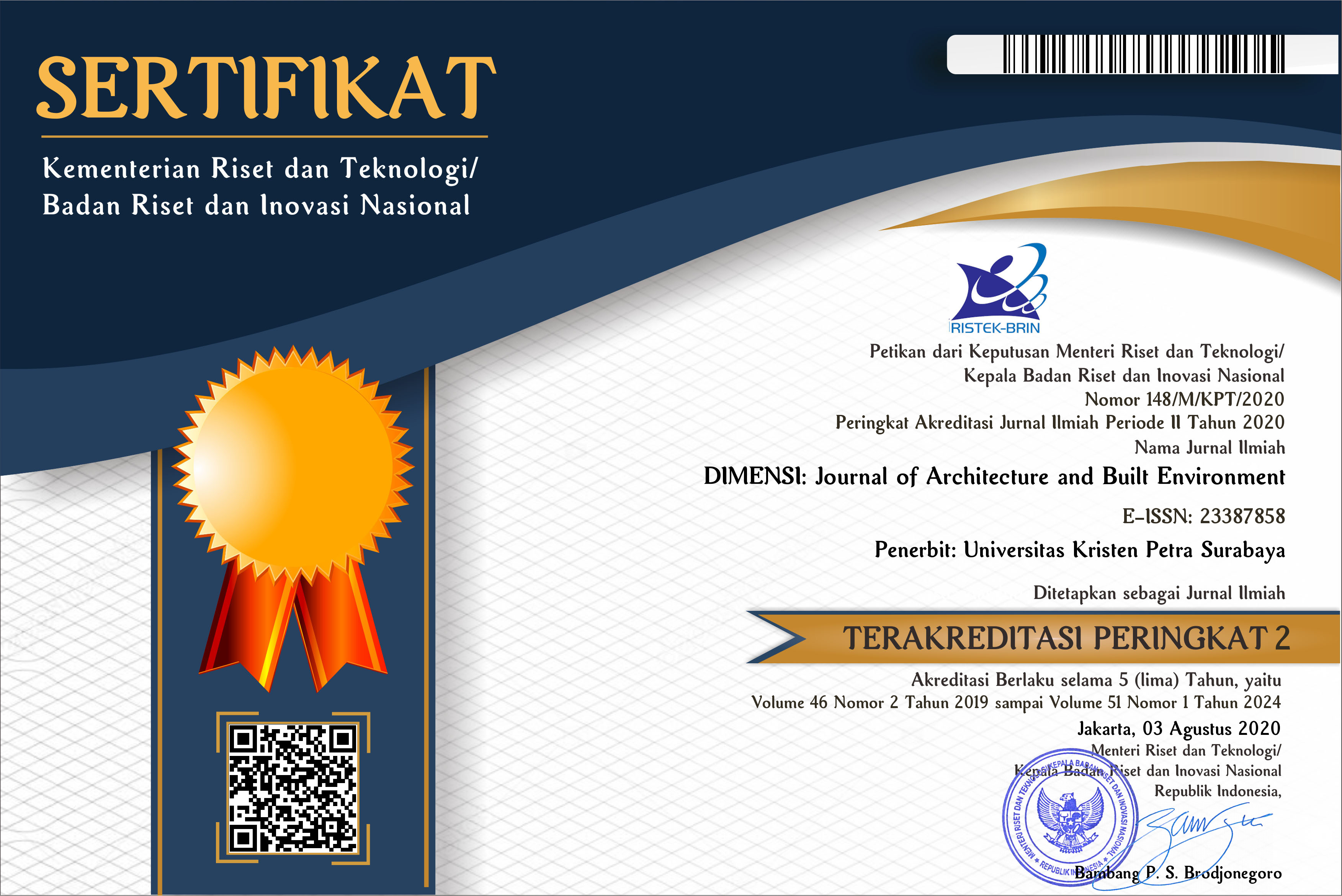AN ARCHITECTURAL ACCULTURATION OF BALINESE, DUTCH, AND CHINESE IN PURI AGUNG KARANGASEM
 :
:
https://doi.org/10.9744/dimensi.49.1.19-30
Keywords:
Puri Agung Karangasem, culture, heritage, architectureAbstract
Bali is one of the many provinces of Indonesia with the most preserved cultural heritage. One form of these heritages is the architectural heritage. The traditional architecture of the Balinese people is still widely used and sometimes repurposed by their own people, mostly the Puris. A Puri is a building that was once used to be the residence of the royal families during their prime. The architecture of these Puris has distinct characteristics on its location, function, and typology of the building. A unique example of these Puris is the Puri Agung Karangasem, which has three cultures infused to its architecture. Apart from the obvious Balinese characteristics, there are also European and Chinese influence which can be proven by the Gedong Maskerdam, Bale Kambang, making it a treasured heritage not only for the Balinese people, but also for Indonesian people in general. This research is meant to explain and to give more insight into the architecture of Puri Agung Karangasem, which in result would present as a piece of knowledge to encourage the community to be more appreciative towards maintaining the traditional architecture of the Balinese people as a piece of important heritage. The method used for this research is the qualitative descriptive method. Focusing on the visual analysis of the architectural elements that are influenced by the different cultures, supported with previous related research and article.
Downloads
References
Agung, A. A. K. (1990). Kupu-Kupu Kuning yang Terbang di Selat Lombok. Denpasar, Bali.
Agung, A. A. P. (1985). ”Kebudayaan Istana Amla-pura”, dalam Peranan Kebudayaan Daerah Dalam Proses Pembentukan Kebudayaan Nasional. Proyek Penelitian dan Pengkajian Kebudayaan Nusantara (Javanologi). Dirjen Kebudayaan Depdikbud, Jakarta.
Akihary, H. (1990). Architectuur en Stedebouw in Indonesie 1870-1970. De Walburg Pers, Zutphen
Ardhana, I K., Trisila S. (2017). Nilai-Nilai Kearifan Dalam Konteks Sejarah Lokal di Bali. Prosiding Seminar Nasional, Masyarakat Sejarawan Indonesia Provinsi Bali.
Berry, Jhon W. (2005). Acculturation: Living successfully in two cultures. International Journal Of Intercultural Relations, 29.
Dwiantari, M. S. & Prajnawrdhi, T. A. (2017). Adap-tasi Arsitektur Tradisional Bali Pada Balai Pertemuan DPRD Renon, Bali. Universitas Udayana, Bali, 2.
Gill, P., Stewart, K., Treasure, E., & Chadwick, B. (2008). Methods of data collection in qualitative research: interviews and focus groups. British Dental Journal, 204(6). DOI: 10.1038/bgj.2008. 192
Goris, R. (2012). Sifat Religius Masyarakat Pedesaan di Bali. Denpasar, Udayana University Press.
Ivashko, Y., Kuśnierz-Krupa, D., & Peng, C. (2020). History of origin and development, compositional and morphological features of park pavilions in Ancient China. Landscape architecture and art, 15, 79. DOI:10.22616/j.landarchart.2019.15. 08
Kalam, T., Subrata, A., & Buda. (1988). Ragam Hias di Puri Karangasem (Laporan Penelitian Dana Penunjang Pendidikan Universitas Udayana). Universitas Udayana, Bali.
Madiun, I. N. (2010). Nusa Dua Model Pengembangan Kawasan Wisata Modern. Denpasar; Udayana University Press.
Maharlika, F. (2018). Studi Multikultural Pada Ornamen Bali Pepatraan: Patra Cina. Serat Rupa Journal of Design, 2(1), 71. https://doi.org/10.28932/srjd.v2i1.478
Mahastuti, N. M. M. (2018). Keunikan Puri Agung Karangasem di Amlapura. Universitas Udayana, Bali, 24-25.
Moedjiono, M. (2012). Ragam Hias dan Warna Sebagai Simbol Dalam Arsitektur Cina. Modul, 11(1), 22. https://doi.org/10.14710/mdl.11.1. 2011. %p
Mohamed, Z. M., Abdul Majid, A. H., & Ahmad, N. (2010). Tapping new possibility in accounting research, in qualitative research in accounting, Malaysian case. Universiti Kebangsaan Malay¬sia, Malaysia.
Munandar, A. A., Sudrajat, E. (2005). Istana dewa pulau Dewata : makna puri Bali abad ke-14-19. Komunitas Bambu. Depok
Nazir, M. (2014). Metode Penelitian. Bogor. PT. Ghalia Indonesia.
Nugroho, A. B., Suryaningtyas, V.W. (2010). Akul¬trasi Antara Etnis Cina dan Jawa: Konvergensi atau Divergensi Ujaran Penutur Bahasa Jawa. Seminar Nasional Pemertahanan Bahasa Nusantara. Semarang: Magister Linguistik PPs UNDIP.
Pribadi, S. S. (2010). Pengaruh Warna Terhadap Ke-budayaan Bagi Masyarakat Tionghoa. Univer-sitas Sebelas Maret, Surakarta, 16.
Redfield, R., Linton, R. & Herskovits, M. (1936) Memorandum for Acculturation. American Anthropologist, 38. https://doi.org/10.1525/aa. 1936.38.1.02a00330
Santoso, G. N., Setiawan, A. P., & Nilasari P. F. (2017). Akulturasi Budaya Bali-Tionghoa pada Interior TITD Ling Sii Miao Tanah Kilap, Denpasar. JURNAL INTRA, Surabaya.
Sulistyawati. (2011). Integrasi Arsitektur Tionghoa ke Dalam Arsitektur Puri Agung Karangasem. Integrasi Budaya Tionghoa Pada Budaya Bali. Universitas Udayana Denpasar, Bali.
Sumantika, W. (2007). Interaksi Budaya Tercermin pada Ornamen. Bali Post, 13.
Tugur, I. B. (1975). Pengetahuan Seni Bangunan Bali. Universitas Udayana, Bali.
Waisnawa, I M. J., & Yupardhi, T. H. (2014). Pengem-bangan Ornamen Tradisional Bali. ISI Denpasar, Bali, 7 & 10.
Downloads
Published
How to Cite
Issue
Section
License
Authors who publish with this journal agree to the following terms:
- Authors retain copyright and grant the journal right of first publication with the work simultaneously licensed under a Creative Commons Attribution License that allows others to share the work with an acknowledgement of the work's authorship and initial publication in this journal.
- Authors are able to enter into separate, additional contractual arrangements for the non-exclusive distribution of the journal's published version of the work (e.g., post it to an institutional repository or publish it in a book), with an acknowledgement of its initial publication in this journal.
- Authors are permitted and encouraged to post their work online (e.g., in institutional repositories or on their website) prior to and during the submission process, as it can lead to productive exchanges, as well as earlier and greater citation of published work (See The Effect of Open Access).


















